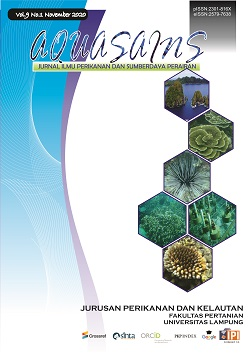Invasive Status of Tarebia Granifera Based on Density of Population in River of Gunung Sejuk Village, South Buton Regency
DOI:
https://doi.org/10.23960/aqs.v9i1.p875-880 Abstract View: 712
Abstract View: 712
Abstract
This research was conducted from May to August 2020, located in the Wandoke Watershed, Gunung Sejuk Village, South Buton Regency. This study aims to analyze the invasive status of the alien species Tarebia granifera based on the perspective of its population density in the river of Gunung Sejuk village. This research is intended to examine the dominance of T. granifera species to local gastropod commodities in the typical habitats and niches of the Wandoke river. Determination of the station or location of the observation begins with a preliminary survey, making it easier to select and determine research stations. Determination of research stations using purposive sampling technique or method of designating stations deliberately, based on the presence of invasive alien species populations of T. granifera and T. granifera sampling using simple random sampling or T. granifera sampling is done randomly in a square transect measuring 100 m2 , using a quadratic transect measuring 1 m2, with the assumption that each point in the transect measuring 100 m2 has homogeneous conditions. The population density of T. granifera at each station in the months of May - August (Spatial and Temporal) shows the size is not much different, where the density range is 21 ind/m2- 43.33 ind/m2. The results of measurement and population density analysis of T. granifera in the waters of the Wandoke river, Gunung Sejuk village is the massive empirical evidence of the invasive pattern of the thiaridae snail.

.png)










